Last updated 23/08/2018
I’ve found there’s a lack of clarity when it comes to information on tyre pressure. There’s lots of conflicting information. I’ve read a lot of it and I’ve accumulated a reasonable amount of experience so this article is the culmination of that knowledge. Hopefully it helps you set correct tyre pressures.
There are many variables related to tyre pressure including tyre specifications (max load, max pressure, construction, dimensions etc), type of vehicle, vehicle loading, suspension characteristics, ambient conditions, speed and type of surface being driven on. There is no single rule that can be universally applied to yield a “correct” pressure. The information here is just my opinion. It’s my best guess at a rule of thumb that can be applied under any circumstances. It’s not perfect. I am not an expert on tyres. This is my interpretation of the information I’ve read and the experiences I’ve had. First I go through general principles and then apply them to a few circumstances.
As with everything in life, tyre pressure involves compromises. There’s no perfect pressure for any circumstance. Changing pressure to improve something invariably makes something else worse. So a judgement needs to be made. My judgements aren’t necessarily right. However from this article you will know how pressure effects various characteristics and you can modify pressure to achieve what you desire whilst at the same time knowing what other characteristics you are compromising.
Comfort
Lower pressure improves comfort. Low pressure allows a tyre to deform quickly to any bumps in the road, insulating the vehicle from the impact. Higher pressure reduces tyre flex and makes for a firmer, bumpier ride.
Traction / Grip
On a hard, smooth surface, pressure does not have much effect on traction, although over-inflated tyres will reduce traction slightly because the tyre cannot conform to the high frequency rumble that comes from any surface that is not perfectly smooth. When encountering bumps, lower pressure provides improved traction. Lower pressure means the tyre stays in better contact with the road as it conforms to bumps. Higher pressure yields less grip over bumps as a tyre bounces and load is temporarily reduced or completely removed if the tyre becomes airborne. A tyre in the air provides no traction at all.
On a surface with hard edges, soft tyres will deform around those edges and provide some mechanical “keying” or interlocking between the tyre tread and the surface edge. This improves traction. A hard tyre will key less and is more likely to slip across a sharp edge.
On a hard surface in wet conditions, higher pressure can increase grip. Higher pressure reduces the contact patch which places more pressure on the water, more effectively pushing the water out the way and providing more grip. The risk of aquaplaning / hydroplaning is also reduced at higher tyre pressures.
Steering Effort
Soft tyres are hard to steer. So lower tyre pressure increases the effort required to steer the vehicle. Higher pressure makes it easier to steer.
Tyre Damage
Sidewalls are damaged by impacting, grinding and slicing across the side of obstacles protruding from the road or track. High tyre pressure reduces sidewall bulge and thus reduces the risk of sidewall damage. Lower pressure increases sidewall bulge and so increases the area of sidewall exposed to potential damage. Low pressure also increases the risk of the rim coming into contact with the tyre tread under an impact load which will damage the tyre and / or rim. So again lower pressure increases the risk of tyre damage in this case. However higher pressure is not universally better in terms of tyre damage risk. Very hard tyres undergo greater impact loading when hitting an obstacle. Softer tyres will flex. Harder tyres will not flex and thus yield a greater force applied to the contact area, potentially damaging the tread by slicing, chipping off small pieces of rubber, ripping off large chunks of rubber or cutting through the tyre via impact fractures. So lower pressure is better to resist this type of damage to the tread surface. Obviously you can’t have hard and soft tyres at the same time, so a compromise is made. Very soft tyres and very hard tyres are both bad for tyre damage. Something in between is best. Driving slowly and picking good lines will help reduce the risk further.
Some people believe keeping tyres rock hard minimizes tyre damage since it helps protect from sidewall damage. I believe sidewall damage risk is overstated. More people suffer impact fractures due to over-inflated tyres. The tread area becomes very vulnerable at high pressures and is much more likely to chip, gouge, cut or fracture. Hard tyres will also be wearing out suspension faster and increasing the chances of suspension failure. From my observations a common denominator in many vehicles experiencing multiple tyre problems and / or suspension problems is super hard tyres. Of course some people with rock hard tyres will argue that they have never had a problem. Differences in load, driving style, terrain and speed may explain this but in general reduced pressure can give you overall reduced risk of tyre and suspension problems.
Another form of tyre damage occurs through overheating (see below under Temperature). Higher pressure reduces the risk of temperature related damage. When running lower pressure, reduce speed so that heat loading does not escalate to dangerous levels.
Tyre Bead
Lower pressure increases the risk of busting the tyre bead. Higher pressure holds the tyre bead firmly to the rim and thus reduces the risk of busting the bead.
Tyre Wear
Generally, higher pressure reduces tyre wear, especially at high speed. Soft tyres have more rolling resistance – this is a form of friction and the energy dissipated wears out the tyre. Another factor may be softening of tread compound due to increased temperature associated with lower pressures. So lower pressure increases tyre wear. Very high pressures can increase wear in the centre of the tyre. Off road, high pressure can increase tread depletion due to chipping and gouging. In this case lower pressure may reduce wear.
Suspension Wear
Pneumatic tyres are able to respond quickly to bumps because they have very little inertia to resist movement. Sudden impact loads are easily absorbed by a pneumatic tyre. It’s the reason why pneumatic tyres are so universal. Suspension on the other hand is heavy. To move suspension quickly in response to a sudden impact requires a very large acceleration force to overcome the combined mass of the suspension, tyres, wheels, axles, etc. A hard tyre will transfer more of the load to the suspension, resulting in a severe spike in stress transfer to suspension components as impact loads are encountered. So lower tyre pressure reduces suspension wear. Low tyre pressure increases the work done by a tyres in response to bumps and reduces the force transferred to the suspension. Tyres at higher pressure are not able to react to bumps as well and transfer more force to suspension components.
If you run rock hard tyres many thousands kms on corrugated roads you’ll soon need new suspension bushes. Keep doing it and suspension failure and even chassis failure are on the cards. Millions upon millions of load cycles soon accumulates to significant fatigue and it’s only a matter of time until something breaks. With reduced tyre pressure you can stretch that failure rate out significantly.
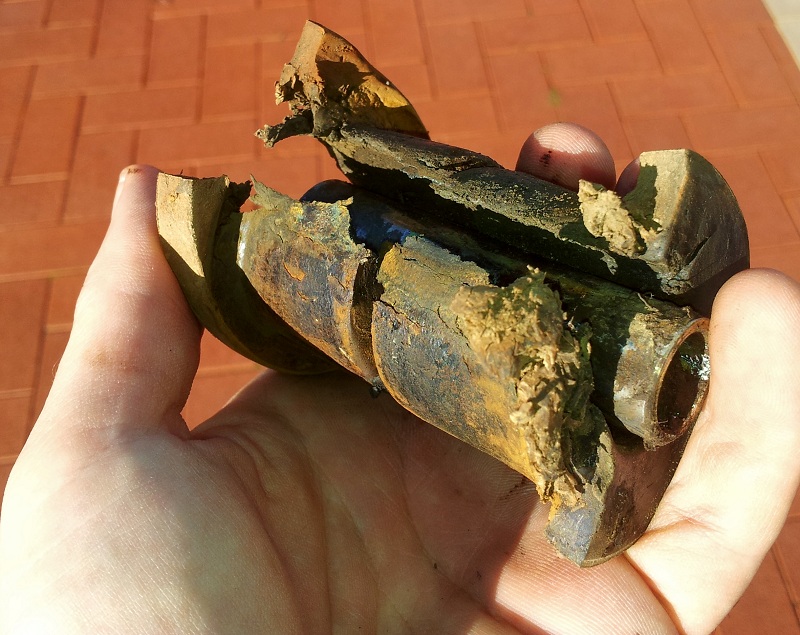
Buggered suspension bushes after many thousands of km of corrugations.
Load
At a given speed, a tyre’s ability to carry load is directly related to its pressure. Higher pressure means ability to carry more load. Lower pressure means reduced load carrying ability. Tyre manufacturers produce tables and charts that specify a tyre’s load carrying capacity according to different inflation pressures.
Temperature
Significant heat is generated by sidewall flex and rolling friction. This means tyres at lower pressure run hotter. Tyres at higher pressure run cooler. Overheating a tyre by under inflation is the most popular way of destroying tyres. Usually it will manifest as a sudden blowout or delamination at speed.
At high speed, heavy loads and high ambient temperatures, a properly inflated tyre may experience temperatures up to 95 deg C. Normal operating temperatures will be less than that. Usually an internal air temperature of around 80 deg C is considered to be a safe for normal conditions. A temperature of more than 100 deg C is a problem and above 120 deg C will see a tyre quickly fail.
Speed
Heat load on a tyre increases with speed. This means at higher speed, to maintain a safe tyre temperature, higher pressures are required. Lower pressure increases temperature and reduces a tyre’s ability to withstand high speed. In other words, when running reduced pressure, speed must also be reduced to offset the additional heat load and maintain a safe tyre temperature.
At any pressure, increasing speed increases tyre wear. Driving slower extends tread life.
Important note: At highway speeds, you must run highway pressure, regardless of surface conditions. At highway speeds you need highway pressure to maintain a safe tyre temperature. Highway pressure can be determined by following the instructions in section “General Tyre Pressure for On-Road” below.
Fuel Efficiency
On hard surfaces, harder tyres have less rolling resistance and thus yield improved fuel efficiency. So higher pressure improves fuel economy. Lower pressure increases rolling resistance which has to be overcome by burning more fuel. See How to Improve Fuel Efficiency for more details.
On soft surfaces like dirt or sand, hard tyres dig in and create extra drag, causing the engine to work harder and more fuel to be consumed. Soft tyres float on top and do not dig into the surface. So reduced pressure offers improved fuel efficiency when traversing soft surfaces.
Ground Clearance and Vehicle Height
Reducing tyre pressure causes the tyre sidewall to deflect more and therefore reduces ground clearance slightly. It also reduces the overall height of the vehicle, which can be useful when you got stuff on the roof rack and you’re trying to fit into a low clearance garage or underground car park. If you accidentally crash into a low clearance obstruction and wedge your vehicle within, reducing the tyre pressure will help to release the vehicle.
General Tyre Pressure for On-Road
Tyre pressure should be measured and set cold. Tyre pressure should be set according to the tyre placard on the vehicle and / or the owner’s manual. This is the minimum tyre pressure for the vehicle under normal on-road driving conditions. The maximum pressure is the pressure rating indicated on a tyre’s sidewall. Never exceed a tyre’s maximum pressure rating.
Increase tyre pressure from that specified by the vehicle manufacturer according to the following criteria:
– if travelling at high speed for long periods of time, for example extended highway runs, increase tyre pressure by 4 psi.
– if carrying a significant load in the order of a couple of hundred kilograms, for example some passengers and their luggage, then increase tyre pressure by 4 psi on the axle carrying that load.
– if carrying a very heavy load, say a fully loaded ute, increase tyre pressure by 6 to 10 psi on the axle carrying that load. An increase of 10 psi would be for say a full tonne in the back of a ute.
– if towing a small to medium load, increase tyre pressure of rear wheels by 4 psi.
– if towing a heavy load, increase tyre pressure of rear wheels by 8 psi.
These pressure increments are cumulative. For example, when set up for touring, my Hilux is loaded pretty heavily with about a tonne in the back, so I increase rear tyres by 10 psi. I’m also doing a lot of highway driving so I increase by a further 4 psi. So that means I am inflating my rear tyres an additional 14 psi over that indicated in the owner’s manual. My front tyres I estimate have an extra couple of hundred kilos of load with the bull bar, stuff at the front of the roof racks and stuff in the back seat which would distribute partly to the front, plus some other miscellaneous items under the hood. That calls for an increase of 4 psi. Again for highway speed I increase a further 4 psi so that the front tyres are running 8 psi higher pressure than the pressure indicated in the owner’s manual.
You may have a situation where the cumulative pressure increments exceed the rated pressure of the tyre. For example if the tyre placard indicates 35 psi and you’re carrying close to a tonne and you’re doing highway work and you’re towing a very heavy load, then the pressure increase would be 10 + 4 + 8 = 22 yielding a total pressure of 57 psi. This high pressure is indicative of the extreme stress and heat load placed on tyres under these conditions. You might be exceeding the tyre’s maximum weight capacity. If the pressure exceeds the maximum tyre rating then use the maximum rating. Do not exceed the maximum rating.
The tyre placard gives the minimum pressure for the factory tyres. Different tyres require different pressures depending on their construction. For example stiffer sidewall tyres generate more heat and thus need to be kept at higher pressures. If you are using the same tyre as the tyre provided from factory, or very similar dimensions and construction of tyre, then the tyre placard is a pretty good starting point. But if you change tyre dimensions or construction (for example go from passenger tyre to 4WD tyre or 4WD tyre to light truck tyre) then you will need to adjust the pressure accordingly. You can use the max pressure and load ratings of the tyres to gauge how much you need to shift pressure but it’s hard to say without full pressure / load charts for each type of tyre.
Speed Derating at Reduced Pressure
The section above gives you the pressure you must have to safely run at the tyre’s speed rating. A speed rating of S corresponds to a maximum speed of 180km/h. How fast can you go at reduced pressure? It’s hard to say. The relationship isn’t perfectly linear, varies from tyre to tyre and depends on many factors that are difficult to account for. However from my research I’ve come up with a rule of thumb that gives an idea as to how slow you need to go at reduced pressure. It may not be too accurate but it’s better than nothing. It’s not very accurate for very low pressure and is mainly useful for mid to high pressure settings.
My rule of thumb is: if you reduce pressure by a factor of x then you need to reduce maximum speed by a factor 2x.
I’ll go through an example to explain. Let’s say I’ve gone through the process above and have determined that the tyre pressure for highway driving is 38 psi. The tyres have a speed rating of 180km/h. Max allowable speed vs pressure would then be:
| pressure reduction (%) | pressure (psi) | speed reduction (%) | speed (km/h) |
| 0 | 38 | 0 | 180 |
| 10 | 34.2 | 20 | 144 |
| 20 | 30.4 | 40 | 108 |
| 30 | 26.6 | 60 | 72 |
| 40 | 22.8 | 80 | 36 |
| 50 | 19 | 100 | 0 |
The table above loses accuracy for low pressures and low speeds. Heat load is not linear and once below around 30km/h tyres will stay cool at almost any pressure. I regularly putter around in the dunes and at the beach all day at pressure much less than the minimum 19psi indicated by the table and the tyres stay cool. On the other hand even with rock hard tyres they soon get bloody hot after a few hundred kilometers at highway speed on a hot day. Accumulation of heat is the problem. Short term deviations above the maximum derated speed are ok. If you are offroading at low pressure and not cruising at much above 30km/h and constantly slowing down for obstacles and sight seeing then you shouldn’t have a problem running low pressure. Use the table more as a guide in situations where you are likely to be moving at reasonable speeds for long periods of time – say for long gravel roads.
Tyre Pressure for Sand
Sand requires low pressure. The softer the sand, the lower the pressure. Reducing pressure makes a massive difference in soft sand. Keep reducing pressure until your tyres float across the top. A typical sand pressure may be around half highway pressure for medium sand or 1/3 highway pressure for very soft sand. Note 1/3 of highway pressure is too low according to the tyre derating formula above, but I’ve never had a problem at low speeds. Keep in mind the increased risk of sidewall damage and busting the bead as pressure is reduced. In emergencies pressure can be reduced further. Do not reduce pressure to the point where the rims are contacting the tread and do not go below around 5 psi to ensure the tyre stays seated on the rim. These extreme low pressures are purely for recovering the vehicle and shouldn’t usually be used. See How To Drive On Sand for more information on correct sand tyre pressure and other details about sand driving.
Tyre Pressure for Rock
Reduced tyre pressure is useful for rock as it improves traction by improving flexibility and helping to maintain tyre contact with the ground. It also improves mechanical “keying” between tread and rock edges which further improves traction. Hard tyres will bounce over rocky terrain and in the process unweighten themselves and lose traction, causing wheel spin and dangerous shock loads through the vehicle’s drivetrain. Low pressure helps reduce the magnitude of jarring impacts that are transferred to the suspension and cabin. Reduced pressure also reduces impact loads on the tyres themselves, reducing the risk of damage. However rock is also risky in terms of sidewall damage. Grinding the sidewall against the side of a rock can cause damage. Also a heavy impact on a sharp rock will heavily deform a tyre at reduced pressure, running the risk of pinching the tyre tread with the rim, causing tyre damage. Similarly very hard tyres are at risk of impact damage and chipping. So rock may call for a pressure about 2/3 to 3/4 highway pressure. Reducing pressure further will help improve traction and stability but expose the tyres to greater risk of sidewall and pinching damage.
Tyre Pressure for Corrugations
Tyre pressure should be reduced for corrugations. There are many benefits afforded by reduced pressure. A significant contribution to corrugation formation is suspension articulation. After a bump, the inertia of the articulating suspension causes it to recede more than the bump, creating an unweighted section of track which will become the peak of a corrugation. As the vehicle advances the suspension’s inertia then causes the recoil to overshoot, increasing pressure on the track and forming the trough of a corrugation. Exiting the trough presents as another bump to the next vehicle which triggers the cycle to continue and another corrugation is formed. This process is reinforced with every vehicle that passes, creating new corrugations and increasing the size of existing corrugations. Reduced tyre pressure means the tyre deforms more and the suspension articulates less, so the suspension’s effect on creating corrugations is reduced. So lower pressure reduces the formation of corrugations. This is a good enough reason on its own for reducing tyre pressure on dirt tracks. Corrugations are expensive to maintain, aren’t fun to drive on and are very bad for a vehicle and its cargo, so any way of preventing them is useful.
Reduced pressure also improves traction, as the tyre remains in better contact with the track surface as the vehicle passes over the corrugations. You may have experienced a dangerous loss of traction when encountering very bad corrugations with the feeling of the rear end of the vehicle drifting sideways across the track. Reduced pressure prevents this situation. Lower pressure also reduces wear on suspension components (see section above on suspension wear), reduces the risk of mechanical failure, improves comfort for occupants and reduces the risk of nuts and bolts coming loose. A typical pressure for a corrugated dirt track may be around 3/4 highway pressure. Extreme corrugations may require say half highway pressure or even less but at such low pressures heat loading may become an issue on long drives and speed must be reduced.
See here for an article about choosing vehicle speed for corrugations.
Tyre Pressure for Mud
Pressure when tackling mud is a compromise between flotation according to the same principle as driving on sand, and bite into firmer soil afforded by harder tyres. Reasonable pressure needs to be maintained to ensure tyre safety when banging around through obstacles and ruts. A starting point may be around 3/4 of highway pressure. Watery mud with a hard base may be ok at full highway pressure. Thick, deep mud with no base at all may require pressure closer to that of sand driving.
Look and Feel
A good habit to get into when touring and offroading is periodically looking at and touching each tyre. Do it whenever you stop.
Look at the tyre and see if the amount of deflection in the sidewall matches the pressure you want to be running. If you want highway pressure then the sidewalls should not be bulging much. If you want an intermediate pressure for gravel then the sidewalls should flex a bit. If you want low pressure for sand then the sidewalls should be bulging a lot. A visual check will help ensure you are running roughly the desired pressure and also provide early warning of a leak.
Touch each tyre to check its temperature. Any temperature that you can indefinitely hold your hand on is ok. If you can hold your hand on for a couple of seconds but feels too hot to maintain contact, then the tyre is probably around the maximum acceptable temperature. Do not reduce pressure or increase speed any more than what you have already been travelling at. If the tyre is too hot for even brief contact then you might want to consider reducing the heat load by increasing tyre pressure and / or reducing speed. If you can smell burning rubber then you might need new tyres.
Whilst you’re checking the tyre temperatures, you might as well touch around the wheel studs and hub. High temperatures could provide early warning of worn bearings or dragging brakes.
If you are running reduced pressure for extended periods of time and at reasonable speed, and you would like to reduce pressure further, first check the tyre temperature. If they are not too hot it means you have some capacity to reduce pressure further. If the tyres are already very hot, reducing pressure may not be advisable, or if you do you’ll need to reduce speed.
If you are experiencing severe corrugations and you’d like to push the limits on reduced pressure, try reducing pressure in increments and regularly check the tyre temperature. Keep airing down until the tyres are quite warm.
What do Trucks Do?
I had a chat to an owner of a 4WD tour business in the Kimblery of WA. He runs trucks with passenger cabins fitted to the tray up and down the Gibb River Road showing tourists around. What pressure does he use on his fleet of trucks for this bumpy and corrugated road? About half highway pressure. For the trucks highway pressure is about 90psi and he runs about 45psi. He does it to reduce risk of tyre damage, reduce suspension maintenance and improve ride quality for passengers. If an owner of a fleet of tucks is reducing pressure on dirt then that’s pretty good evidence that reduced pressure is of benefit.
I’ve talked to truckies about tyre pressure on road trains. Some trucks are fitted with systems to deflate and inflate tyres at the push of a button, similar to what is found on Hummers. It’s sometimes used for road trains doing regular offroad / on road commutes, for example transporting minerals from mines to port. They run reduced pressure for dirt tracks and then pump them up for the highway run. If big road trains are reducing pressure on dirt then that’s pretty good evidence that reduced pressure is of benefit.
References
http://www.bridgestone.com.au/tyres/passenger/care/pressure.aspx
Checkout outbackjoe on facebook
See also:
How to Improve Fuel Efficiency
Bridgestone Dueler D694 14,000km Review
Why Wide Tyres Don’t Help in Sand

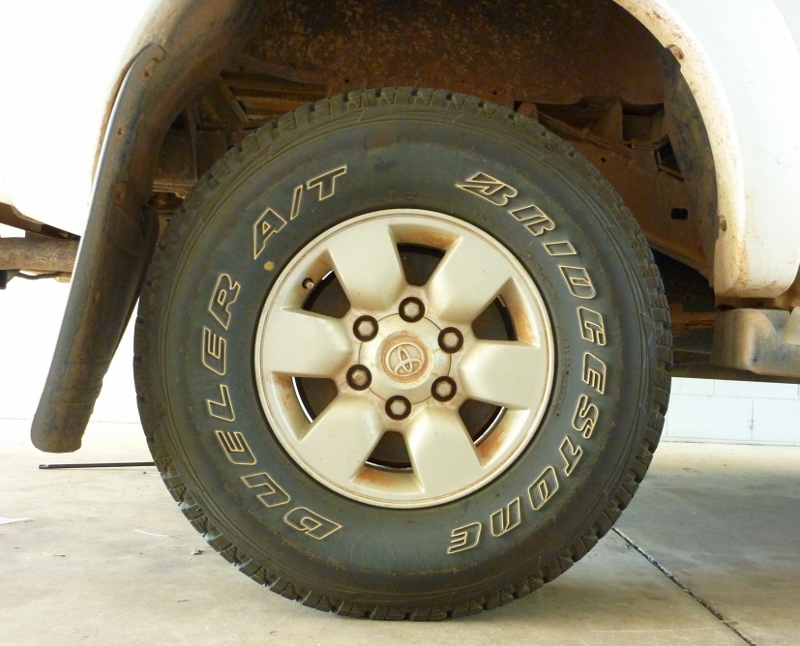
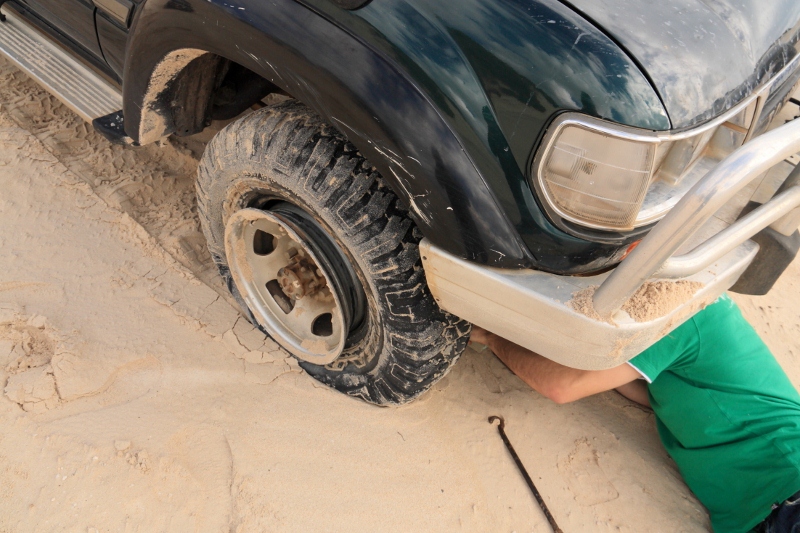
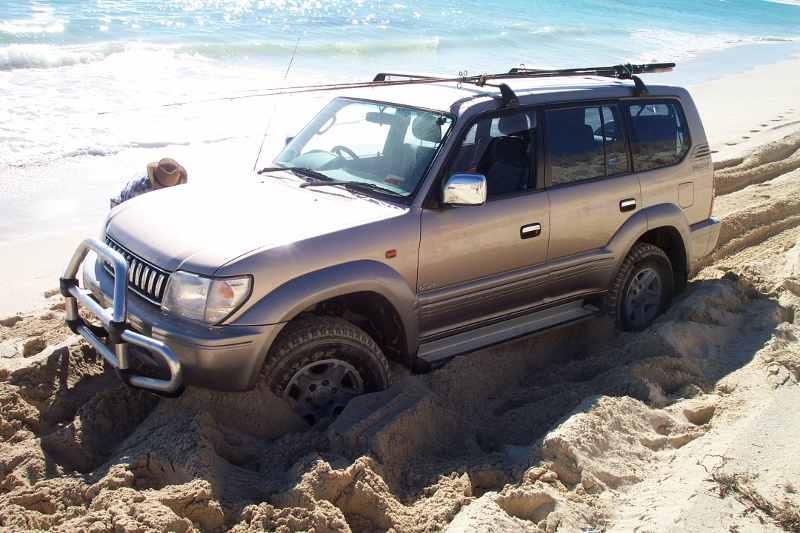
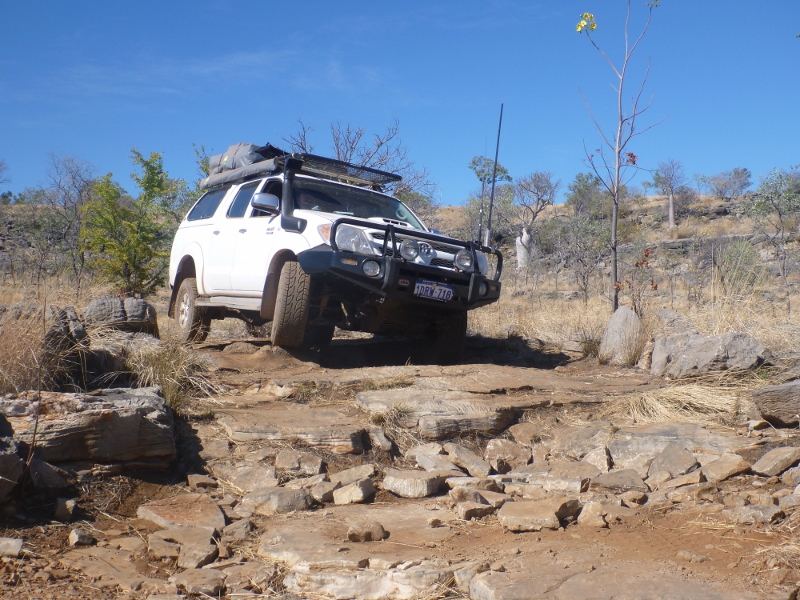
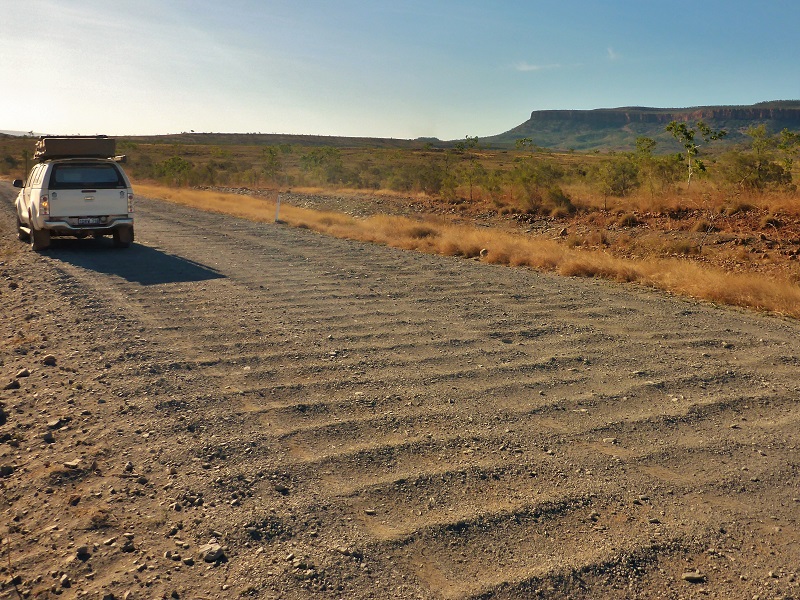
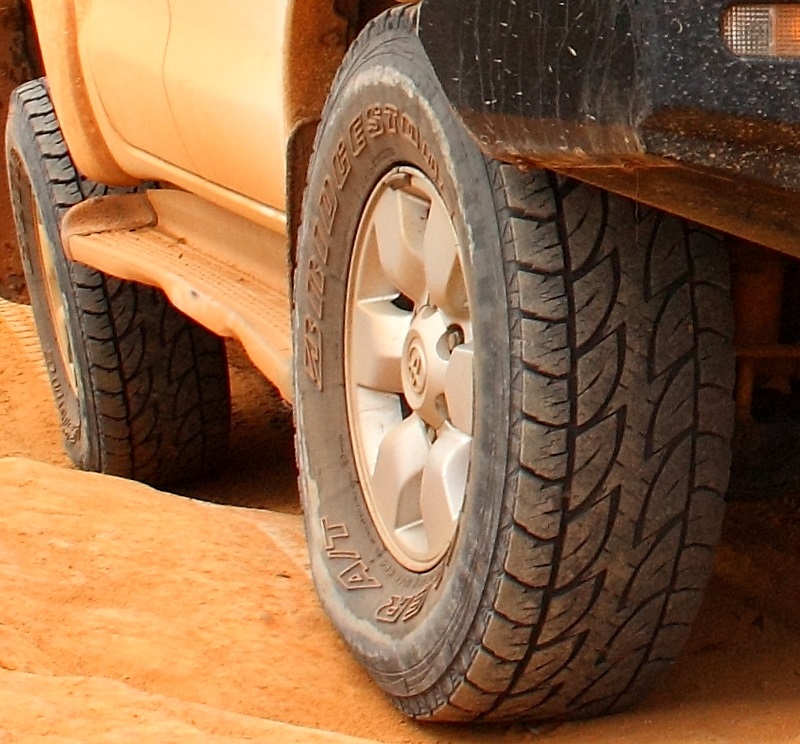


Thanks. A very useful run-down.
You’re welcome happy motoring.
good read mate cheers
no worries dude
yep great read well researched. cheers
Cheers dude.
I really enjoy reading your informative posts Outback Joe, I like the fact they’re all based on your own “real world” experience – keep up the great work.
Q. What pressure were you running on the highway when you had your Sierra?
Hey Matt going camping with the sierra loaded up I had the tyres at 36psi all round, which was the max pressure of the tyres it had.
Hi OutbackJOE,
you’re on the mark in regards tyre pressures. You’ve provided a great guide to tyres!
The key to tyre pressures is to not exceed 15% above your cold pressure setting.
Tyres will increase in pressure as they work, if they are over working then the pressure increase is above 15%. Minor separations start and over time these will grow until there is a physical delamination of the tread from the tyre casing. The road gators you see on the roadside aren’t necessarily from retreads, new or virgin tyres do this as well in response to over work / heating.
A real time tyre pressure monitor will give you a clue as to what your tyres are doing. The very first thing you do when you stop after a highway haul is to check your tyres, drives first, using your own gauge. I mean first, not after you’ve fueled up or grabbed a coffee, car tyres will cool off quickly. They are back to ambient within 1 hour.
Tyres are the only thing between your vehicle and the road, look after them and they’ll look after you, ignore them at your own peril.
Hi Adam cheers for your feedback dude. Yeah I do a visual on my tyres most times I stop, to make sure they don’t look flat, and every few stops I do a bushman’s temperature check with my hand. Pretty rough.
At last – an article which gives specific advice rather than general advice such as “reduce tyre pressures” but does not tell you to what. I intend to drive the Gibb next year in an Apollo 4WD Camper van and will take your advice to reduce pressures to around 25 and drive slowly. I I’ve in London and there is not much call for 4WD techniques here!
Hey Paul glad I could help, enjoy the Gibb, I aint done it but it’s on my list.
Great read mate, thanks for this, solid info in my opinion.
Cheers dude.
Excellent info. Well done
Seems the way to go for rough gravel roads with sharp rocks is around 3/4 of highway pressure. Do you also have an approximate rule of thumb for vehicle speed at this reduced pressure?
Hey Mike at 3/4 highway pressure limit speed to half speed rating of the tyre. This is a rough guess.
Thanks for the article.
As I’m planning a trip up the westcoast I found your website very helpful!
Thanks for this great article. I have a sprinter 4×4 Motorhome at maximum GVM with LT tyres and was worried about reducing pressure for corros and sand which would have put me under the recommended psi for the load ratings.. Your article was very informative.
Cheers
No worries glad the article was helpful
Hi joe
I am new to 4 WD ing and after a brief encounter with soft sand south of Pemberton WA , I have been scanning the net on sand driving. I found your well written article very informative and based on sound principles.
I have an Amarok with 18 ” rims and reasonably low profile tyres , from other information I thought I may have to get higher profile tyres that would belly out” more when deflated but it sounds like I just need to let a bit more air out of the ones I have!
I have been toying with the idea of making some grips , of various designs, that I could strap on the tyres (snow chains) . There must be a way to drive on sand without deflating the tyres? i.e. Big Lizzie , Redcliffe (Mildura). Do you think there would be any benefit in this pursuit or will I just be creating ways to get bogged quicker.?
Jeff Cadzow
Hey Jeff yes of course anything is possible and you can make a car capable of going on sand without deflating tyres. The compromises are massive though. As an extreme escape you could turn your car into a hovercraft. But that would be expensive and hovercrafts have many drawbacks. You can go for something like mattracks which give your car something like caterpillar tracks. But then you can’t go above 30km/hr and they are heavy and expensive and time consuming to fit every time you want to drive on sand. Snow chains or similar I don’t think will work, they will not help prevent getting bogged since they do not increase surface area. Actually they could make it worse by digging in quicker. You need to increase surface area, like tracks or those planks on big lizzie (top speed less than 2km/hr). I think you’ll find letting down the tyres to be the best solution to the problem. That’s why we don’t have any big lizzie style vehicles roaming around. Anything that needs reasonable handling and speed capability uses normal pneumatic tyres at reduced pressure. Anything that needs extreme flotation and traction uses tracks. Snow chains some a different problem. They do not help with getting bogged but they increase friction on snow and ice.
Joe,
Just read your bit on sand driving. Great! Just what I have been looking for forever.
Just got back from a week on Moreton Island sand driving for the first time – wish I had read you before I went.
Anyway tyre pressures were down to 16 psi and all was well.
I have a Nissan Navara tray-top and also a side-on with dry weight of around 580 kg.
If I were to try the slide-on on sand would 16 psi be OK or should I go lower?
Many thanks’
Ian
Yo Ian you gotta see how the car handles and how flat the tyre looks with the extra weight. Keep airing down until the tyres float on top but keep an eye on how flat the tyres look. You might need to actually go a couple of PSI higher on the back to keep adequate clearance between rim and bottom of tyre. When I’m fully loaded for touring 15 psi is about the minimum I would go and even then the tyres look a bit too flat and I need to drive very carefully. That makes it a bit difficult on the softest sand but lower pressure may damage the tyres.
Guys,
it’s not just about how the tyre looks, radials are deceiving in appearances, it’s about how the tyre reacts to the load & speed. Using real time monitoring we have observed that speed is the biggest factor, when you’re running low pressures do not be tempted to speed as this will cause your tyres to over heat. Just like over baking a cake once the damage is done it can’t be undone. Tyre failure may not happen in the near term, but it will happen usually when you’re at highway speeds. I’ve examined many tyre failures over years, nearly all (>95%) are inflation pressure related. A tyre sees no difference in over load or under inflation. Real time tyre pressure monitoring informs you what the tyre is experiencing, in all conditions.
Hey guys need to no a quick question my 17 inch all terrain tyres on a toyota frotune 4×4 what would the standard type pressure be 2.2 or 2.5 for asphalt driving on a daily basis
Good to go very informative very helpful. Will take a lot of it away with me. Must put a smile on your dial to know you’ve helped mostly complete strangers. But who knows we might catch up out on the tracks. Thanks Colin
Hey Colin glad to help enjoy your bush trekking.
Hey mate, I’m towing a Jayco expanda outback which weighs about 2 tonne with a Prado, the back end of the car looks really low, what tyre pressures would you suggest, car is loaded up to, boot full and roof rack chockers
Cheers Andy
Hey Andy probably your springs are sagging a bit. Check tow ball weight from jayco and make sure it is correct ratio of total weight. Car might be overloaded, prado can only take about 600kg and that includes tow ball weight and occupants so doesn’t leave much for extra cargo. You might have to put up with a saggy ass unless you upgrade springs or get a ute. Could redistribute stuff towards front or into jayco. Tyre pressure you really gotta go through the process outlined in the article. Start with manufacturer recommendation and work your way up based on application.
Great article – lots of good information, real numbers, no bullshit.
Hi Joe,
a question if I may
I drive a Prado 120 2006 with STD tyres 265/65/17, Just fitted brand new Bridgestone duelers, (did a trip and got one puncture & 5 sidewall leaks) – so im changing tyres.
related to you post, will the be any benefit changing from 265/65 to 265/70 ?
Jan
Hi Jan bigger overall tyre will give you bit more ground clearance and bit more space to run low tyre pressure. There’s negative impacts like reduced acceleration, poorer braking performance, increased torque load on drivetrain. Don’t think it will help much with tyre failures unless they were caused by low pressure tyre getting pinched by rim. What was the go with the sidewall leaks?
Hi Joe,
I found that the prado is just too heavy, when deflated to 0.8 bar, I still don’t “float” on the sand (Beach/dunes).
My thought was, get wider tyres – until I read your article on wider tyres for sand use.
The reason I want to dump the (3500km new) Bridgestone Duelers 265/65-17 is due to 5 leaks on 3 tyres on the sidewall, very small, only causing slow leak (0.1Bar in 24 hours). I have “fixed” that with Wynn’s tyre weld, but my tyre supplier was not amused by this and washed it out.
Back to why i’m NOT impressed with the Duelers … in 21 year using Goodyear (265/75-15) Wranglers on my Mitsubishi, I have not had a single puncture (Kevlar I assume), and been driving a certain part of the north west Cape coast in South Africa for 10 years and NEVER got stuck / never got a puncture. The landscape is semi-desert, fine brush, no thorn trees, very little rock. The Colt is lighter and the tyres allow for a bigger footprint.
This is the 1st time I used the Prado – got stuck 2 x times, so bad that I had to be recovered. So running on 0.8 bar I picked op small punctures. Judging by the size of the leaks, it must have been a very tiny “thorn” on the sidewall touching the surface, later pointed out by a local – a small seed with 3 to 5mm “horns” – see picture
(https://www.grainsa.co.za/upload/images/3%281%29.jpg)
So I decided to go back to what I know & trust, Wrangler’s with kevlar.
While I’m there, I thought why not to bigger & wider. But then I ran into all issues, some ideal size was not manufactured, others were too big (touching body) and of course, other were 3 to 4 times more expensive.
After 2 weeks of searching, I narrowed it down to Wranglers 265/65-17 or 265/70-17 (as they dont do a 275 and also based on your article)
The “70” will add 26mm to diameter and give me 12mm more on the sidewall height – the idea is that I will end up with a bigger footprint when deflated, compared to the 265/65.
p.s. The prado/colt are only used to drive 1500km there & 1500km back (mostly tar) Then doing 1000km in the desert. At home they are not day-to-day cars. So the acceleration/braking etc is not too much of a concern
One more issue, with the Duelers, I would do the pressure 2 bar when cold (Toyota specifies 1.9Bar) , drive 100km on tar and check the pressure – gone up to 2.6/2.7Bar, I think that’s excessive (say if I’m wrong) – the previous Michelins did not react the same way, on the prado.
Hi Jan its unusual that you couldn’t float. Usually any tyre will do the job at the right pressure. How flat did the tyres look at the pressure you reduced to? Potential problems could be stiffer side walls requiring lower pressure, or pressure gauge losing accuracy at low pressure so pressure could be higher than indicated. If tyre didn’t look very flat perhaps there was scope to air down more.
Also unusual is getting punctures from thorns, are the tyres passenger construction?
Bigger diameter will help be able to run lower pressure without running out of sidewall room.
Thanks Joe,
really value & appreciate your input / advice
1. they did in fact look very flat
2. not sure about the stiffness of the sidewall on the Bridgestone Dueler 265/65-17 BST D694 112s
3. I have checked my handheld gauge with a tyre shop, even they were impressed about the accuracy, so no doubt there
4. as per model number above, they should be offroad
thanks, so I’m going for 265/70-17 then, will have the garage confirm I have 12mm spare for clearance
That size might come in 2 options passenger construction and LT. Check if tyres have LT on them. Make sure your new set are LT.
Maybe you’re rig is just really heavy. In that case going bigger helps, you need room for lower pressure.
from their website .. classified as 4×4 all terrain tyres
Bridgestone Dueler 265/65-17 BST D694 112s
“The Dueler D694 All Terrain tyre offers performance in the best and worse road conditions with a comfortable ride and superior handling.”
I made up my mind, going back to Goodyear Wranglers with Kevlar in the sidewall, as they never suffered a puncture in 15 years on a Mitsubishi Colt.
Weight, not high load, BUT – the Prado is very heavy … ampty
D694 is out of production so I can’t confirm 100% but the D697 specs which supersede it indicates 265/65r17 112 is passenger construction whereas 265/65r17 116 is LT. So if it’s the same then your tyre is passenger construction.